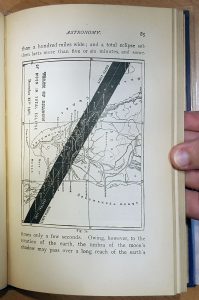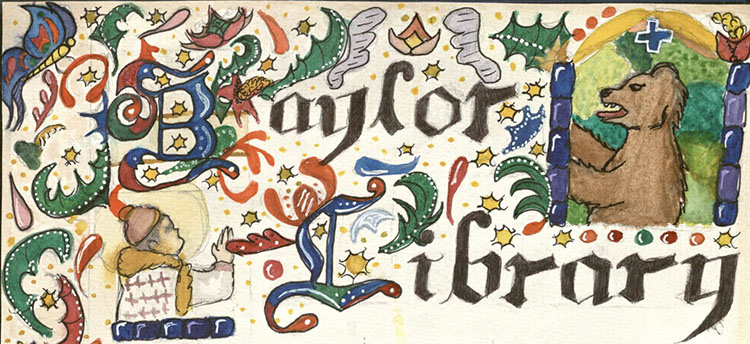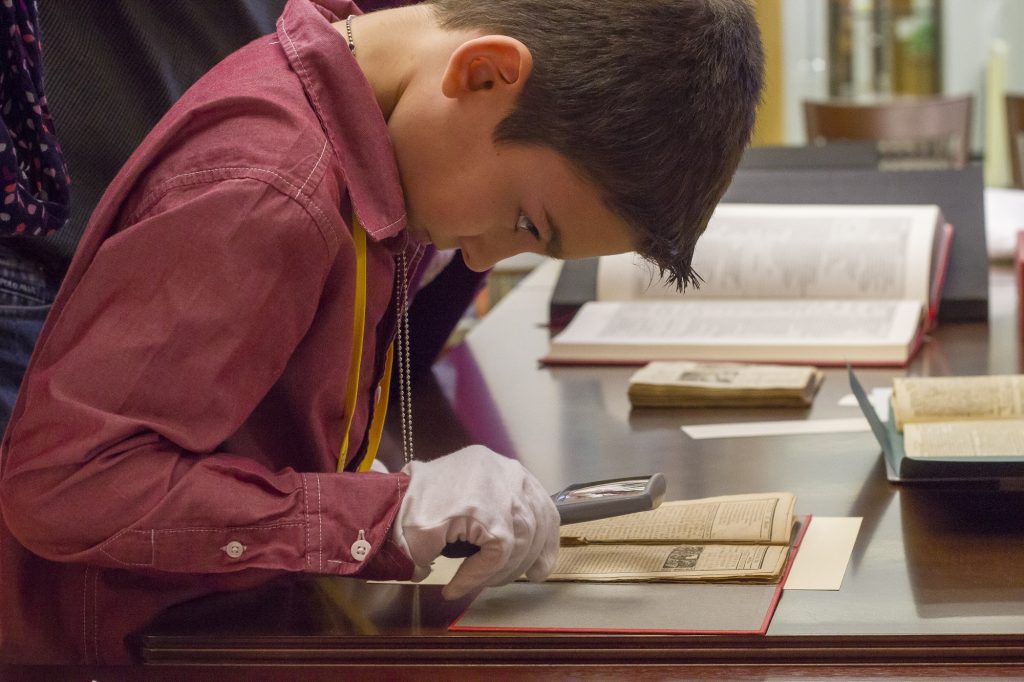In light of the upcoming solar eclipse on August 21st, special collections catalogers Allie McCormack and Susan Bowlin share some rare books from the Central Libraries' Polk and Hughes collections that discuss the subject.
For as long as they have been gazing skyward, humans have studied eclipses and tried to explain them. Many of these explanations understandably involved the sun being eaten: the ancient Norse believed that wolves devour the sun during a solar eclipse, while the Mayans believed the sun had been swallowed by a serpent. Though these stories are fascinating, here we will describe several of the items in the Baylor Libraries that discuss eclipses in more scientific terms.
 This book, the Libellus Astronomicus, is a textbook of astronomy written by German scholar Bernhard Hederich in 1598. It doesn’t resemble modern textbooks at all — there are few illustrations, and instead of simply explaining astronomical concepts to readers, it posits questions in the style of a Socratic dialogue. It is almost entirely in Latin, with some Greek and German phrases mixed in.
This book, the Libellus Astronomicus, is a textbook of astronomy written by German scholar Bernhard Hederich in 1598. It doesn’t resemble modern textbooks at all — there are few illustrations, and instead of simply explaining astronomical concepts to readers, it posits questions in the style of a Socratic dialogue. It is almost entirely in Latin, with some Greek and German phrases mixed in.
If you look closely, you will notice that the German words are printed in a different typeface than the other text. In the early days of European printing technology, certain fonts were affiliated with different cultural groups (like Italic type being used in Italian books). Latin was the language of universities and scholarship during this time period, so the inclusion of German words in this book suggests it may have been made specifically with a Germanic audience in mind. Even so, this audience would have been educated: literacy levels were low, and only advanced scholars would have been able to read Greek as well as Latin.
 This next textbook, Hiram Mattison’s Elementary Astronomy, will probably look more familiar. It is structured around distinct lesson plans and has an appendix of “Questions for Examination.” The preface tells us that it was created specifically for primary schools, but this wasn’t for students to use on their own. Instead, this was a book for teachers, and the preface includes suggestions for how instructors could use the book in their classes. The picture to the right shows a table of solar eclipses that would be visible in Europe and North America from 1847, the year before the book was published, to 1900. Though for a younger audience, this book was grounded in the latest scientific knowledge.
This next textbook, Hiram Mattison’s Elementary Astronomy, will probably look more familiar. It is structured around distinct lesson plans and has an appendix of “Questions for Examination.” The preface tells us that it was created specifically for primary schools, but this wasn’t for students to use on their own. Instead, this was a book for teachers, and the preface includes suggestions for how instructors could use the book in their classes. The picture to the right shows a table of solar eclipses that would be visible in Europe and North America from 1847, the year before the book was published, to 1900. Though for a younger audience, this book was grounded in the latest scientific knowledge.
 This next picture is from Gillet & Rolfe’s 1883 textbook First Book in Astronomy. The book shows a professionalization of teaching: the writers are a professor and a former school headmaster, and there is more of a pedagogical focus in the text. There are even sections of the text that could be abridged or omitted by the classroom teacher, printed in a smaller typeface for distinction. A full 10 pages are devoted to eclipses, with questions printed after each section. There are many illustrations and diagrams throughout the text; the one to the right shows the path of a lunar eclipse in 1871.
This next picture is from Gillet & Rolfe’s 1883 textbook First Book in Astronomy. The book shows a professionalization of teaching: the writers are a professor and a former school headmaster, and there is more of a pedagogical focus in the text. There are even sections of the text that could be abridged or omitted by the classroom teacher, printed in a smaller typeface for distinction. A full 10 pages are devoted to eclipses, with questions printed after each section. There are many illustrations and diagrams throughout the text; the one to the right shows the path of a lunar eclipse in 1871.
The paper used in this book does not feel as soft as the previous textbook, and it is more acidic in content. The rise of compulsory schooling laws throughout the late 19thcentury likely created a demand for more textbooks, and new printing and papermaking technologies allowed books to be created faster and more cheaply. However, these pages in these books are prone to chipping, and they may be more fragile and in worse condition than books many decades older.
Textbooks weren’t the only way Americans learned about eclipses. Almanacs, annual publications that were written for the general public, contained weather-related predictions, dates of religious celebrations, information on the local government, and even literature. Solar eclipses affected the tides and animal behavior, so it would have been important for fishermen, farmers, and others to know when these were going to occur in a given year.
 The almanac pictured to the right, a 1761 edition of Poor Richard Improved, is one of the more erudite American almanacs of the period. Besides calendars and tables, it contained poetry, essays, and practical advice for everyday living, including tips for making advantageous friendships. This sophistication is even evident in its section on eclipses, which contains a large illustration showing the mechanism of a lunar eclipse. The stylistics of this almanac may be due to its writer and printer, renowned polymath and Founding Father Benjamin Franklin. It is telling that the eclipses were described not at the beginning of the volume, as in most other almanacs of the period, but rather at the very end. This may suggest that Franklin was writing for the urban elites of Philadelphia rather than rural workers.
The almanac pictured to the right, a 1761 edition of Poor Richard Improved, is one of the more erudite American almanacs of the period. Besides calendars and tables, it contained poetry, essays, and practical advice for everyday living, including tips for making advantageous friendships. This sophistication is even evident in its section on eclipses, which contains a large illustration showing the mechanism of a lunar eclipse. The stylistics of this almanac may be due to its writer and printer, renowned polymath and Founding Father Benjamin Franklin. It is telling that the eclipses were described not at the beginning of the volume, as in most other almanacs of the period, but rather at the very end. This may suggest that Franklin was writing for the urban elites of Philadelphia rather than rural workers.
 Contrast this with the next almanac, Ames’ Astronomical Diary, also for the year 1761. Information about eclipses comes even before the calendar in this volume. It is not illustrated, making it cheaper to produce, and had no literature and very little poetry. Instead, it contains practical articles on world coinage, fermenting wine out of currants (a type of berry), and the treatment of smallpox.
Contrast this with the next almanac, Ames’ Astronomical Diary, also for the year 1761. Information about eclipses comes even before the calendar in this volume. It is not illustrated, making it cheaper to produce, and had no literature and very little poetry. Instead, it contains practical articles on world coinage, fermenting wine out of currants (a type of berry), and the treatment of smallpox.
Franklin’s almanac also contained an article about smallpox. This highly contagious disease, which had a mortality rate of about 30%, was endemic throughout the world until the practice of vaccination became widespread at the end of the 19th century. Outbreaks occurred regularly in Colonial America, and indeed one had taken place from 1755-1756. Though both books contained information about the spread of and treatments for smallpox, they had different focuses. Ames’ almanac specifically described how to clean and disinfect houses where people had been infected by smallpox, once again showing its focus on practical knowledge.
 Practicality is also emphasized in this volume of the New England Farmer’s Diary and Almanac, published in Vermont in 1820. Its calendar is extremely detailed, and the astronomical tables have both solar and lunar calculations. The eclipse chart is again at the front of the book and includes the latitude and longitude coordinates for the path of the eclipse. Instead of literary works, the almanac contains epigrams about weather and gardening as well as longer treatises on agricultural topics. It was clearly intended for a rural, working audience.
Practicality is also emphasized in this volume of the New England Farmer’s Diary and Almanac, published in Vermont in 1820. Its calendar is extremely detailed, and the astronomical tables have both solar and lunar calculations. The eclipse chart is again at the front of the book and includes the latitude and longitude coordinates for the path of the eclipse. Instead of literary works, the almanac contains epigrams about weather and gardening as well as longer treatises on agricultural topics. It was clearly intended for a rural, working audience.
Though the previous almanacs showed age-related yellowing of the paper, this one has visible dark spots and staining. As we mentioned earlier, this is likely due to the higher acid content of the paper. The cheaper and faster production meant that this almanac could reach a wider audience than previous works, but this came at a cost. Indeed, this volume may be in worse condition than the textbook from 1598 featured at the beginning of this post!
We hope you have enjoyed reading about some of the eclipse-related books in the Central Libraries Special Collections. To see any of these items for yourself, or to learn about other scientific works in these collections, start with our webpages and plan a visit.
https://www.baylor.edu/lib/centralspecialcollections/
Works mentioned:
Astronomical diary, or an almanack... Boston: B. Green,1761. (Polk AY201 .B7 A63 1761)
Gillet, J. A. First book in astronomy. New York: Potter, Ainsworth, & Co., 1883. (Hughes QB45 .G47 1883)
Hederich, Bernhard. Libellus astronomicus. Rostock: Mylandrinis, 1598. (Polk QB26 .H43x 1598)
Mattison, Hiram. Elementary astronomy. New York: Huntington and Savage, 1848. (Hughes QB46 .M44 1848)
The New England farmer’s diary and almanac. Windsor, Vt.: Jesse Cochran, 1820. (Hughes AY321 .W565x N48 1820)
Poor Richard improved. Philadelphia: B. Franklin and D. Hall, [1760](Polk AY53 .P6 1761)























